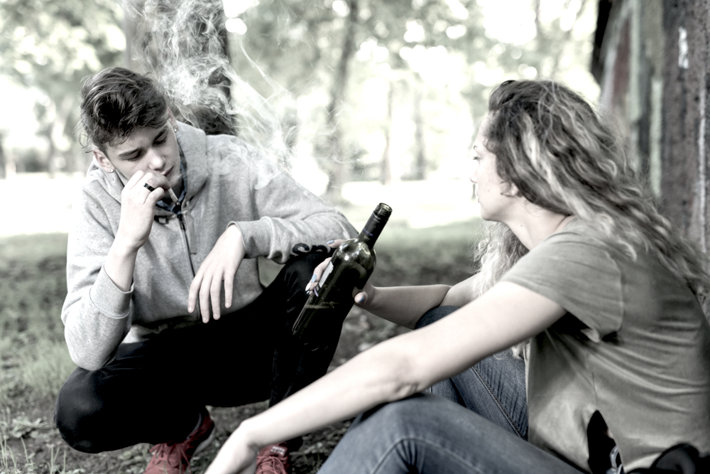Are Teens Less Likely to Misuse Drugs and Alcohol?

Any area or arena of drug and alcohol misuse is concerning and unpleasant, but few areas are as concerning or as unpleasant as teen drug use is. When we examine the wider spectrum that is 21st-century drug and alcohol addiction, we can see that just about every age range and demographic is mired in some form or type of drug addiction problem or another.
However, the age-range where people are the most at risk for experimenting with drug abuse is one’s teen years and early twenties. And to make matters worse, the age range where people tend to injure themselves the most or where they tend to experience other adverse effects of drug use the most is coincidentally also one’s teen years and early twenties.
How We Perceive Teen Drug Use
The drug use scene amongst teen and young adult demographics has changed considerably in the last twenty years. This area went from little to no problems to massive problems, essentially overnight. In a direct quote from the National Institute on Drug Abuse as of two years ago:
“This year’s Monitoring the Future (MTF) survey of drug use and attitudes among 8th, 10th, and 12th graders in hundreds of schools across the country continues to report promising trends…”
“This year’s Monitoring the Future (MTF) survey of drug use and attitudes among 8th, 10th, and 12th graders in hundreds of schools across the country continues to report promising trends, with past-year use of illicit drugs other than marijuana holding steady at the lowest levels in over two decades, i.e. 5.8 percent among 8th graders, 9.4 percent among 10th graders, and 13.3 percent among 12th graders. This is down from peak rates of 13.1 percent for 8th graders in 1996, 18.4 percent for 10th graders in 1996, and 21.6 percent for 12th graders in 2001.”
During the 1990s and the early to mid-2000s, teen and young adult drug use statistics were the lowest they had been in almost thirty years. The nation rejoiced, for it seemed that we had finally fostered a generation of American youth who were not at all interested in experimenting with drugs and alcohol. However, around the mid-2000s, this all changed when young people began experimenting with highly addictive and potentially lethal pharmaceutical drugs.

The sad truth is that, just in the last two years, teen and young adult drug use statistics have begun to soar, threatening to reach highest-ever levels. And what’s more concerning, the types of substances that young people are using are far more dangerous and potentially lethal than the substances that young people were misusing even just a few years ago. High-strength opioid painkillers, mind-altering psychotropic drugs, potent street drugs mixed with lab-made stimulants, and synthetically-altered marijuana are the talk of today, potent drugs that get young people addicted after just one use.
Statistics on Drug Use Amongst Youth Demographics
Multiple organizations have done a fair amount of research on youth drug use trends. Groups like the National Survey on Drug Use and Health, the Centers for Disease Control and Prevention, and the Substance Abuse and Mental Health Services Administration, and the annual Monitoring the Future Survey have worked together to put together research information like the following:
- High school-age American youth are now more likely to partake in marijuana use than cigarette smoking. This is part and parcel to the increasing rate of marijuana legalization across America. As marijuana becomes increasingly legal, young people perceive it to carry significantly less risk than it used to be associated with.
- On the subject of perceived risk, the 2016 Monitoring the Future Survey found that teens today do not have the same outlook on drugs as teens in earlier generations did. Nowadays, young people perceive far fewer risks attendant with casual drug use than they once did. This is concerning as it indicates that they will be more likely to misuse drugs than if they perceive less risks associated with such activities.
- More teenagers die from overdoses on prescription drugs than from all other street drugs combined. Our younger generation is becoming a generation of pill-poppers, teens who are more likely to get ahold of illicitly obtained prescription pills and experiment with those than teens who are likely to experiment with hard street drugs.
- Drug use is the single most common reason for teens and young adults in their early twenties to visit the emergency room. Twenty-seven percent of these visits are related to prescription drug abuse, twenty-one percent of such visits were related to illicit drugs, fourteen percent of the visits were related to a combination of alcohol and drug use, and the rest came from alcohol misuse and drunk driving.
- According to the Substance Abuse and Mental Health Services Administration, though at least three million American youth between the age of fifteen and twenty-five meet the criteria for a full-on drug habit or alcohol addiction, only about eleven percent of them will ever receive the proper treatment for their substance abuse habit.
- According to the Centers for Disease Control and Prevention, when young people misuse drugs and alcohol, they are statistically speaking more than twice as likely to experience a serious accident, injury, overdose, arrest, or another negative consequence as a result of that experience than an older adult is. And furthermore, when young people misuse drugs, even just recreationally, they stand a far greater risk of becoming addicted to that substance than older adults do.
This is just a brief insight into the dangers and risks that young people bring on when they engage in drug use and alcohol misuse.
Raising a Generation of Drug-Free Youth
The challenge of raising a generation of drug-free youth is one that grows more and more complicated as time wears on. We were going in the right direction for a while there, but the 21st-century pharmaceutical drug addiction epidemic and a rising interest in pharmaceutical drugs amongst teen and young adult demographics has absolutely set us back a spell.
Now, we need to up the ante in our efforts to crack down on teen and young adult drug abuse. Young people are still staying away from hard drugs for the most part, but they are showing increasing interest in prescription drugs and alcohol, which are just as bad. And young people are using marijuana at unprecedented rates. Marijuana is a gateway drug, so this too is something to be concerned about.

We have to make it our duty, as a unified American people, to educate our young people about the dangers and risks attendant with drug use and alcoholism. This has to be the primary approach going forward, or we shoot ourselves in the foot by raising a generation that shows remarkable interest in drugs and alcohol.
According to the Substance abuse and Mental Health Services Administration, when young people know the risks attendant with drugs and alcohol, they tend to stay away from such substances, because they know just how bad drugs are and how risky they are, and just how dangerous alcohol is. When they don’t know the risks, all manner of hell can break loose. SAMHSA reports that youngsters who are educated about drugs and alcohol are more than four-hundred percent less likely to misuse drugs, yet only one-third of parents take the time to educate their kids in this area. That needs to change.
Sources:


 ®
®